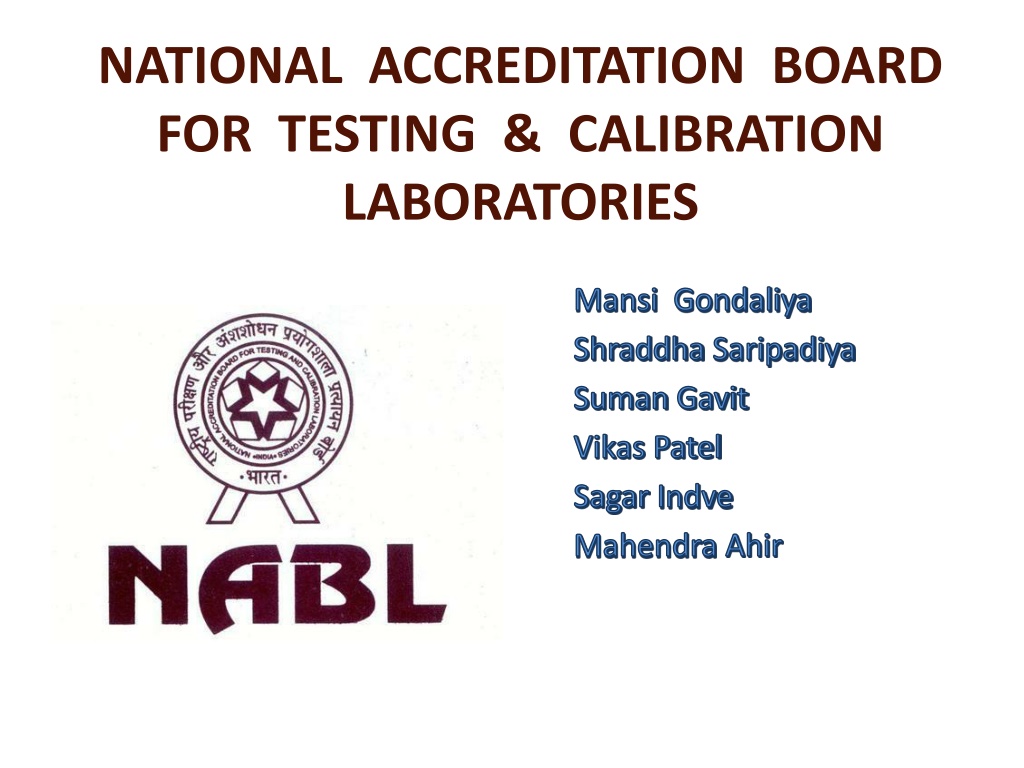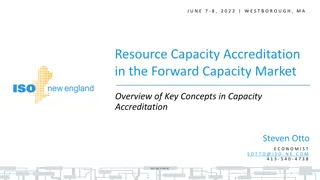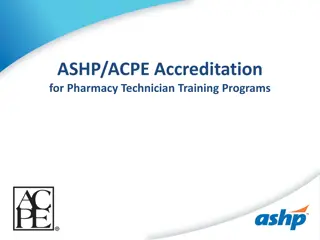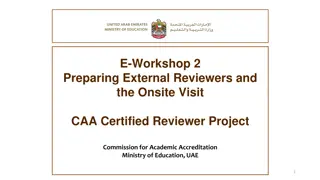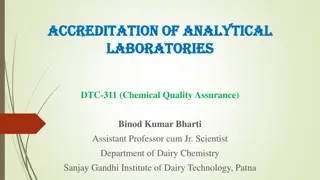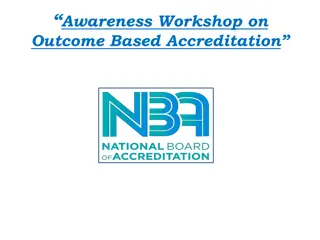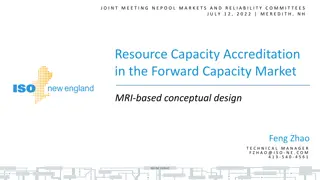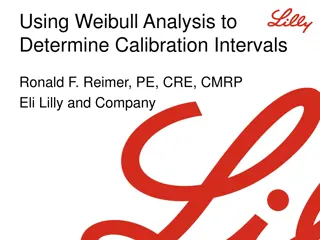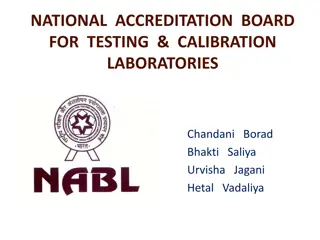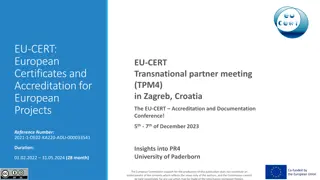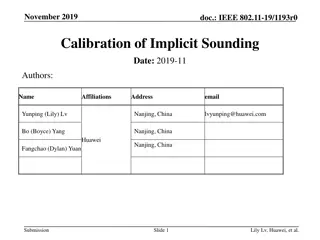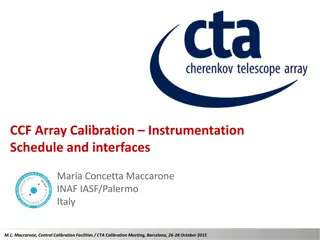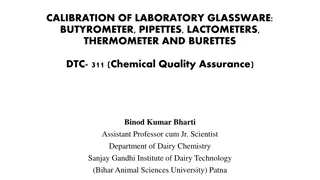Understanding National Accreditation Board for Testing & Calibration Laboratories (NABL)
NABL, under QCI in India, grants accreditation to medical laboratories based on ISO standards like ISO 15189. Learn about NABL's role, ISO guidelines, and accreditation processes through this comprehensive information.
Download Presentation

Please find below an Image/Link to download the presentation.
The content on the website is provided AS IS for your information and personal use only. It may not be sold, licensed, or shared on other websites without obtaining consent from the author. Download presentation by click this link. If you encounter any issues during the download, it is possible that the publisher has removed the file from their server.
E N D
Presentation Transcript
NATIONAL ACCREDITATION BOARD FOR TESTING & CALIBRATION LABORATORIES Mansi Gondaliya Shraddha Saripadiya Suman Gavit Vikas Patel Sagar Indve Mahendra Ahir
NABL National Accreditation Board for Testing and Calibration Laboratories Under QCI of Government of India The accreditation of medical laboratories are granted according to requirement of ISO 15189:2012 NABL 112
General information NABL web site www.nabl-india.org/ How to find ISO 15189:2007 https://www.iso.org/standard/42641.html How to find ISO 15189:2012 https://www.iso.org/standard/56115.html How to find NABL-112 www.nabl- india.org/nabl/file_download.php? filename=201207131010-NABL-112...
How to find NABL Document www.nabl-india.org/ Publication(home page) NABL document (all list ) 153 Application form for Medical Testing laboratories 208 Pre-Assessment Guidelines & forms
ISO of Different category ISO15189 - How to Manage Quality of Medical Laboratories ISO9000 - Definition of Quality Management ISO9001 - How to Manage Quality of Any System ISO17025 - How to Manage Quality of Testing & Calibration of Laboratories
1. NABL National Accreditation board for testing and calibration laboratories. 2. NABH - National Accreditation board for hospitals and health care providers. 3. MRA Mutual Recognition Agreement 4. ILAC International laboratory accreditation cooperation. 5. APLAC Asia pacific laboratory accreditation cooperation. 6. LIS laboratory information science. 7. IQC Internal quality control. 8. EQAS External quality assurance scheme. 9. ILC Inter Laboratory Comparison 10. ISO International organization for standardization 11.QCI Quality council of India
13. IEC International electro-technical commission. 14. WDI Work Desk Instruction 15. SOP Standard operating procedures. 16. TRF Test Request Form 17. TAT Turn around time. 18. CLIA clinical laboratory improvement amendment. 19. CLSI clinical and laboratory standards institute. 20. CV Coefficient of variation 21. SD Standard Deviation 22. TE - Total Error 23. TAE Total Allowable Error 24. CAB Conformity Assessment Bodies 25. QM- Quality manager 26. TM- Technical manager 27. LD- Laboratory director.
Mutual Recognition Agreement ISO (ILAC), APLAC and NABL are interconnected. ISO,APLAC,NATA & NABL linked to the same standardization (ISO) in testing procedures. MRA indicate synchronization of standard requirement between all bodies. Example . ISO laboratory personnel should be competent for intended purpose. NABL MLT , B.Sc. , M.Sc NATA - depend on their respective country criteria.
Scope of NABL Accreditation Testing laboratories Calibration laboratories Medical laboratories 10
Scope of NABL Accreditation TESTING LABORATORIE STERIAN CALIBRATION LABORATORIES MEDICAL LABORATORIES Biological Chemical Electrical Electronics Fluid-Flow Mechanical Non-Destructive Testing Photometry Radiological Thermal Forensic Electro-technical Mechanical Fluid Flow Thermal & Optical Radiological Clinical Biochemistry Clinical Pathology Haematology & Immuno- haematology Histopathology Cytopathology Genetics Nuclear Medicine (in-vitro tests only) Proficiency Testing Providers Reference Material Procducers Testing Calibration Medical Inspection Chemical Composition Biological & Clinical properties Engineering properties Miscellaneous Properties 11
Calibration laboratories Electro-Technical Electric current Magnetic field Mechanical Speed Rotation Radiological X rays illustration management Thermal Temperature Optical Light wave length Fluid-Flow Flow rate
Preparation of CAB before applying for NABL Accreditation Four days Internal Audit training for Technical staff and authorized signatory Training for all laboratory personnel. Define Organigram of Laboratory Appoint quality manager who has done Internal Auditor Course as per ISO:15189:2012. Designate QM, TM & LD EQAS & IQC for all parameters Preparation of Quality Manual / Quality System
Preparation of CAB before applying for NABL Accreditation Define Quality Policy & Objective Finalization Documentation & Implementation of Process Procedure (Quality System Procedure) Preparing SOP and WDI related to different process Internal Audit - Gap Analysis - Gap filling Management Review Meeting Corrective Preventive Actions Process to NABL
Information About Laboratory Required by NABL Name of Authorized signatory - Qualification , Experience , Training Organigram Quality Manual Scope of accreditation (Test) - Name of Method ,Name of Test/Principle/Range of Testing Information about Instrument - Calibration & Manufacturer Quality Control Material - Lot number , CV% Reference / Control Material - Provider , Lot number
Benefits of Accreditation 1. Promise to clients about good laboratory practice 2. National and international recognition 4. Provides global similarity 5. Provides comparability in measurements of test results 6. Doctors can rely on test results 7. Improve staff motivation for work with system. 8. Confidence in the event of legal challenge 9. Saves money by putting system in work for good service.
ACCREDITATION PROCESS Application for Accreditation (by Laboratory) Feedback Acknowledgement & Scrutiny of Application (by NABL Secretariat) to ) Laboratory Adequacy of Quality Manual (by Lead Assessor) and Pre-Assessment of Laboratory (by Lead Assessor) Necessary Final Assessment of Laboratory Corrective (by Assessment Team) Action Scrutiny of Assessment Report by (by NABL Secretariat) Laboratory Recommendations for Accreditation (by Accreditation Committee) Approval for Accreditation (( by Chairman NABL) Issue of Accreditation Certificate (by NABL Secretariat)
Other definitions Accreditation Procedure by which an authoritative body (NABL) gives formal recognition that an organization (Laboratory)is competent to carry out specific tasks . Quality Degree of fulfillment of specific characteristic with specific criteria. For Glucose, Total allowable error as per CLIA is <10% Biochemistry laboratory has TE of 5% for glucose
Quality Management System QMS is to direct and control an organization to maintain quality. It is document to control and direct all process like the pre- examination, examination and post-examination processes. Quality policy Overall intentions and direction of a laboratory related to quality Formal promise New Civil Hospital Laboratory Services Surat (NCHSLS) is committed to provide accurate, reliable and timely medical laboratory services.
Inter laboratory comparison To compare test value with other laboratory to check performance and evolution. For example, Compare Glucose value with SMIMER hospital laboratory. Randox EQAS programme In this programme more than 1000 laboratory participate. Laboratory reports is compare with all this laboratories .
CAL less_than 6.5 Critical interval Interval of examination results for test that indicates an immediate risk to the patient. CHE less_than 3000 GLC less_than 55 GLC less_than 30 IBIL more_than 15 K less_than 3 K more_than 5.5 TBIL more_than 15
Biological reference interval or Reference interval specified interval of values taken from a biological reference population. For example, RBS reference interval = 70-140 mg/dl, Abnormal RBS = > 140 mg/dl, Critical RBS = > 300 mg/dl. Documented procedure Documentation of specified way to carry out any activity or a process. For example, documentary procedure for performing ADA test.
Nonconformity Nonfulfillment of a requirement For example, Internal quality control value for Glucose goes out of 3 SD. Laboratory technician got needle pick injury during blood collection. Point-of-care testing (POCT) Near-patient testing Testing performed near or at the site of a patient Example : Glucometer
Clauses & Sub clauses 4.1 Organization and management Guideline about legal identity registration of organization ethical issues responsibility of different laboratory person. 4.2 Quality management system What to write QMS. document, procedure, WDI, Organization chart
4.3 Document Control Labeling and identification of different document. all documents are identify to include, Title Unique identifier on each page; The date of current edition and/or edition number Page number to total number Authority of issue. 4.4 Review of contracts. It is related to agreement with customer(patient), user and doctor. Which test can be done or not done Which procedure when report available = TAT how report will be available.
4.5 Examination by referral laboratories About selection and evolution of referral laboratory. 4.6 External services and supplies Procedure for how to purchase equipment, consumable reagents. 4.7 Advisory services About interpretation of result, scientific review. 4.8 Resolution of complains Procedure to respond complain and feedback. 4.9 Identification and control of nonconformities(refusal) Procedure for identification and immediate action , corrective action, preventive action and authorized person to response NC. 4.10 Corrective action To eliminate cause of nonconformities.
4.11 Preventive action For prevention of nonconformities. 4.12 Continual improvement Add new test, decrease TAT, improve techniques, improvement more specific result.
4.13 Quality and technical records records shall include at least the following; Staff qualifications, training and competency records; Request for examination Records of receipt of samples in the laboratory Examination results and reports; Instrument maintenance records, Calibration functions and conversion factors; Quality control records; Nonconformities identified and immediate or corrective action taken; Complaints and action taken; Records of internal and external audits; Interlaboratory comparisons of examination results;
4.14 Evaluation & Audits 1. Plan & implement to the internal audits 2. Patient& doctors feedback 3. Staff suggestion 4. Internal Audit 1. Self evaluation of laboratory about technical and management requirement as per ISO 15189:2012 & NABL 112 5. Risk management 6. Quality indications 1. IQC & EQAS 2. TAT 3. Sample flow 7. Reviews by external organization 4.15 Management review Management meet with N.C. related to management Role of management to resolve this N.C. Discussion about Risk management & Continueal improvement
Technical requirements 5.1 Personnel Personal qualification The laboratory provide training for all personnel : The quality management system; Assigned work processes and procedure; The applicable laboratory information system;(LIS) Heath and safety, including the prevention or containment of the effects of adverse incidents; Needle pick injury BMW management training Mercury spillage as well as sample spillage Fire extinguisher training Ethics; Confidentiality of patient information.
5.2 Accommodation and environmental condition Staff facility Patient facility Testing facility Storage facility Disposal facility
5.3 Laboratory equipments, reagents and consumables. 5.3.1. Equipment - Calibration - Maintenance 5.3.2. Reagents and Consumer - Verification - Validation - Inventory - Storage.
5.4 Pre-examination procedures Request form Primary collection manual Information of patient & users during sample collection. Sample collection Sample transport Sample reception 5.5 Examination procedure About examination procedures.
5.6 Assuring quality of examination procedure Related to frequency of IQC and EQAS Drawing of L J chart Interpretation of L J chart Interpretation of ILC Root cause analysis of IQC & EQAS 5.7 Post-examination procedures About review of results Storage, retention and disposal of sample.
5.8 Reporting of results identification of the examination identification of the laboratory . identification of all examinations done by referral laboratory patient identification and location Date of primary sample collection type of primary sample; Name of procedure, Results SI units biological reference range interpretation of results Authorized signature date of the report, and time of release page number
5.9 Release of results Technical personnel shall be well trained. Issues a final report after verifying Results of the tests. Reports records should be maintain for revise. 5.10 Laboratory information management Patients security and confidentiality maintain Access to LIS should be restricted.
CAP ACCREDIATION PROCESS CAP =College of american pathologist The CAP does not accrediate portion of laboratories. The laboratory is awarded a ''CAP Laboratory Accrediation''certificate upon successful completion of the inspection process and becomes part of an exclusive group of more than 7600 laboratories worldwide that have met the highest standards of excellence.
Standard for CAP Accreditation Standard 1- Director & Personnel Standard 2- Physical Resources Standard 3 - Quality Management Standard 4 - Administrative Requirement
Standard for CAP Accreditation Standard - 1 Relates to the qualification, responsibility and role of the Director. Standard - 2 Concerns the Physical resources of laboratory. Space, Instrumentation, commnication and data processing system, reagent and other supplies, ventilation, piped gases and water, public utilities, storage and waste disposal..
Standard 3 - Encompasses quality management . System validations. QC of preanlytic,analytic,and post analytic process Proficiency testing Standard 4 - Administrativerequirements Comply with the required specified in the standard in the term of accreditation checklist.
